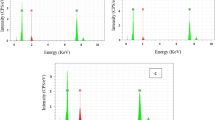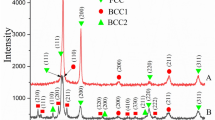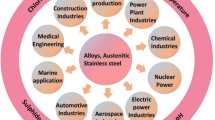Abstract
A technique for analyzing new corrosion-resistant ruthenium-doped titanium alloys using inductively coupled plasma atomic emission spectrometry (ICP-AES) with microwave sample preparation is reported. The composition of a mixture of acids and the temperature and time parameters of sample preparation of titanium alloys under microwave heating in an autoclave ensuring quantitative conversion of the sample into a convenient analytical form without loss of volatile components for subsequent ICP-AES analysis are substantiated. Optimal conditions for the excitation of the analytical signal have been found, and analytical lines of elements without spectral noise have been selected. Samples of experimental melts of industrial titanium alloys of various classes, volumetrically doped with ruthenium, which are under development and are not yet commercially produced in the Russian Federation (alloy PT-7M + Ru, PT-3B + Ru, 5B + Ru, 37 + Ru, VT-22 + Ru) have been studied. The alloy samples contained the following alloying elements (wt %): Al (1.8–6.3); V (1.0–5.5); Mo (0.7–5.5); Zr (0.2–3.0); Cr (0.5–1.5); Fe (0.5–1.5); Ru (0.05–0.15). The correctness of the determination of alloying elements has been confirmed by analyzing standard samples by varying their mass and, in the case of ruthenium, by the “introduced–found” method. The developed method significantly reduces the time of analysis by combining the multielement ICP-AES method with microwave sample preparation, expands the list of detectable elements in titanium alloys, and improves the precision of the results of analysis.
Similar content being viewed by others
REFERENCES
Il’in, A.A., Kolachev, B.A., and Pol’kin, I.S., Titanovye splavy. Sostav, struktura, svoistva: spravochnik (Titanium Alloys. Composition, Structure, Properties: Handbook), Moscow: Vseross. Inst. Legk. Splavov, 2009.
Gorynin, I.V., Ushkov, S.S., Khatuntsev, A.N., et al., Titanovye splavy dlya morskoi tekhniki (Titanium Alloys for Marine Engineering), St. Petersburg: Politekhnika, 2007
Kudriavtsev, A.S. et al., RF Patent 2426808, Byull. Izobret., 2011, no. 23.
ASTM E2371-13: Standard Test Method for Analysis of Titanium and Titanium Alloys by Direct Current Plasma and Inductively Coupled Plasma Atomic Emission Spectrometry (Performance-Based Test Methodology), West Conshohocken, PA: ASTM Int., 2013. https://doi.org/10.1520/E2371-13
ASTM E539-11: Standard Test Method for Analysis of Titanium Alloys by X-Ray Fluorescence Spectrometry, West Conshohocken, PA: ASTM Int., 2011. https://doi.org/10.1520/E539-11
Titov, V.I., Goundobin, N.V., and Kotikov, V.N., Determination of ruthenium in heat-resistant nickel alloys by atomic emission spectrometry with inductively coupled plasma, J. Appl. Spectrosc., 2013, vol. 80, no. 4, pp. 477–481.
Kablov, E.N., Karpov, Yu.A., Titov, V.I., et al., Rhenium and ruthenium determination in nanostructured high-temperature alloys for aerospace engineering, Inorg. Mater., 2015, vol. 51, no. 14, pp. 1363–1369.
Inamoto, I., Progress of analysis technologies for titanium, Nippon Steel Tech. Rep., 2002, no. 85, pp. 149–156.
Mosichev, V.I., Kalinkin, I.P., and Nikolaev, G.I., Analytical control of the composition of materials of ferrous and nonferrous metallurgy, in Metally i splavy. Analiz i issledovanie (Metals and Alloys: Analysis and Research), Mosichev, V.I., Ed., St. Petersburg: Professional, 2007, book 3.
Kubrakova, I.V., Microwave radiation in analytical chemistry: the scope and prospects for application, Russ. Chem. Rev., 2002, vol. 71, no. 4, pp. 283–294.
Leonov, V.P. et al., RF Patent 2439183, Byull. Izobret., 2012, no. 1.
GOST (State Standard) 19807-91: Wrought Titanium and Titanium Alloys, Grades, Moscow: Standartinform, 1992.
Sansonetti, J.E. and Martin, W.C., Handbook of basic atomic spectroscopic data, J. Phys. Chem. Ref. Data, 2005, vol. 34, no. 4, pp. 1559–2259.
Zaidel’, A.N., Prokof’ev, V.K., Raiskii, S.M., et al., Tablitsy spektral’nykh linii: spravochnik (Tables of Spectral Lines), Moscow: Nauka, 1977, pp. 649–656.
Mermet, J.M., Use of magnesium as a test element for inductively coupled plasma atomic emission spectrometry diagnostics, Anal. Chim. Acta, 1991, vol. 250, pp. 85–94.
ACKNOWLDGMENTS
This study was performed using the equipment of the Center for Collective Use of Scientific Equipment Composition, Structure, and Properties of Structural and Functional Materials of the National Research Center Kurchatov Institute—Central Research Institute of Structural Materials Prometey.
Funding
This work was financially supported by the Ministry of Science and Higher Education of the Russian Federation, project no. 14.595.21.0004, identifier no. RFMEFI59517X0004.
Author information
Authors and Affiliations
Corresponding authors
Additional information
Translated by D. Kharitonov
Rights and permissions
About this article
Cite this article
Vyacheslavov, A.V., Malinkina, Y.Y., Bichaev, V.B. et al. Analysis of Corrosion-Resistant Ruthenium-Doped Titanium Alloys by Inductively Coupled Plasma Atomic Emission Spectroscopy. Inorg Mater 55, 1365–1370 (2019). https://doi.org/10.1134/S0020168519140140
Received:
Published:
Issue Date:
DOI: https://doi.org/10.1134/S0020168519140140




